Dynamic Music NFTs: Emerging as a Unique Way to Redefine Artist-Fan Interactions In 2024-25
The music industry, like many others, has been heavily impacted by the digital revolution. Streaming platforms have become the primary way people consume music, and this shift has brought significant changes to the relationship between artists and their fans. While platforms like Spotify and Apple Music offer convenience, they also limit the ways in which artists can interact with their audience and monetize their work.
However, a new technological innovation is beginning to disrupt the traditional model: Dynamic Music NFTs. These non-fungible tokens (NFTs) are a unique and evolving approach to music ownership and engagement, offering musicians an entirely new way to connect with their fanbase. Dynamic Music NFTs combine the power of blockchain technology with the creativity of music, allowing for a more personalized, interactive, and rewarding fan experience.
In this article, we’ll explore what Dynamic Music NFTs are, how they work, the benefits they offer to artists and fans, and why they are poised to change the music industry as we know it.
Key Highlights
- Music Industry Transformation: Dynamic Music NFTs represent a paradigm shift in the music industry, giving artists new tools to engage with their audience.
- Blockchain and Music: By integrating blockchain technology, Dynamic Music NFTs offer musicians the ability to directly monetize their work without intermediaries like record labels or streaming platforms.
- Enhanced Fan Engagement: Fans can enjoy interactive, personalized experiences with their favorite artists through dynamic NFTs, creating a deeper bond between the two.
- Ownership and Scarcity: Dynamic Music NFTs offer real ownership and scarcity of music, something that traditional streaming platforms cannot provide.
- Future Outlook: The future of Dynamic Music NFTs looks promising, with new platforms and creative possibilities emerging every day.
What Are Dynamic Music NFTs?
Dynamic Music NFTs are digital assets on the blockchain that combine music with the features of NFTs, creating a unique and evolving form of ownership. Unlike traditional NFTs, which represent a static asset like a piece of digital artwork, Dynamic Music NFTs are designed to evolve or change over time based on certain factors or interactions. This dynamic nature gives both artists and fans an innovative way to engage with music.
At the core of Dynamic Music NFTs is the idea that music is not just a one-time, static experience. Instead, it’s something that can grow, change, and interact with its environment. Through blockchain technology, music NFTs can be programmed to include different features, such as changing the song’s mix, adding new remixes, or unlocking exclusive content over time.
For instance, an artist might release a song as a Dynamic NFT that evolves based on the listener’s interactions with it. This could include changing the musical composition based on how many times it’s played or offering bonus tracks to fans who hold the NFT for a certain period. Fans who purchase these Dynamic Music NFTs become active participants in the artist’s work, not just passive listeners.
How Do Dynamic Music NFTs Work?
Dynamic Music NFTs function through blockchain technology, the same decentralized ledger system that powers cryptocurrencies. However, while most NFTs are stored as immutable, one-time assets, Dynamic Music NFTs are coded to allow modifications or changes to the music file over time.
Here’s a breakdown of how they typically work:
1. Blockchain Technology
Like traditional NFTs, Dynamic Music NFTs are hosted on blockchain networks such as Ethereum, Solana, or others. The music file itself is usually stored off-chain, but the ownership and metadata—such as whether the NFT has been modified or whether new content has been unlocked—are securely recorded on-chain. This decentralized ledger ensures transparency and verifiability, and also protects the artist’s rights and ownership.
2. Smart Contracts
The dynamic features of the NFT are often governed by smart contracts—self-executing contracts with the terms directly written into code. These smart contracts can dictate how the music evolves, what triggers changes, and when fans can expect new content or features to unlock.
For example, an artist could set up a smart contract that releases new versions or remixes of a song every month for a year. As fans continue to hold the NFT, they would receive updated versions of the song as the contract dictates. This creates an ever-changing, ongoing experience for fans, keeping them engaged long after the initial purchase.
3. Interactive Fan Engagement
The “dynamic” aspect of Dynamic Music NFTs can also include interactive elements that allow fans to customize their experience. For example, fans could unlock behind-the-scenes content, access exclusive live streams, or even participate in the creative process by submitting their ideas or feedback. This level of interactivity is rare in traditional music distribution and represents a new way of building a community around an artist’s work.
Benefits for Artists
Dynamic Music NFTs present a variety of benefits for artists, providing them with new ways to engage with their fanbase and generate revenue.
1. Direct Monetization
One of the biggest challenges for musicians in the streaming era is the relatively small revenue they generate per stream. Streaming platforms like Spotify and Apple Music pay musicians a fraction of a cent per play, which makes it difficult for most artists to sustain a living wage. Dynamic Music NFTs provide a direct way for musicians to monetize their music.
By selling Dynamic NFTs, artists can earn a larger share of the revenue. Since the transaction is conducted on the blockchain, there are no middlemen like record labels or streaming platforms taking a cut. This allows musicians to retain a more significant portion of the earnings from their work.
2. Exclusive Content and Experiences
Dynamic Music NFTs enable artists to offer exclusive content and experiences to their fans in a way that’s not possible through traditional music distribution. Fans who own these NFTs can unlock special remixes, VIP access to virtual events, or even early access to new releases. This helps foster a sense of exclusivity and loyalty among the artist’s audience.
Moreover, artists can use NFTs to offer limited-edition versions of their songs, personalized messages, or live performance recordings, creating an additional layer of engagement.
3. Building Stronger Fan Relationships
With Dynamic Music NFTs, artists can build stronger, more personal relationships with their fans. Instead of simply listening to a track and moving on, fans can interact with the music, unlock new versions of it, and become part of the creative journey. This level of fan engagement helps create a more dedicated and invested audience, leading to greater long-term support for the artist.
4. Decentralized Ownership and Control
Dynamic Music NFTs give artists full control over their music. With no intermediaries involved, artists can distribute their music in a decentralized way, ensuring that they maintain ownership and control of their intellectual property. Additionally, smart contracts can be programmed to ensure that artists continue to receive royalties every time their music is resold, allowing them to benefit financially from the secondary market.
Benefits for Fans
While Dynamic Music NFTs offer many advantages to artists, they also provide unique benefits for fans. These benefits go beyond simply owning a digital copy of a song—they create a deeper, more meaningful connection between fans and the artists they love.
1. True Ownership
Unlike traditional music distribution, where fans only own a copy of a song but not the rights to it, Dynamic Music NFTs provide true ownership. By purchasing a Dynamic Music NFT, fans have a verifiable, blockchain-backed claim to the music. This gives them a sense of pride and investment in the artist’s work, knowing that they hold a unique and limited edition of the song.
2. Personalized Experiences
Dynamic Music NFTs allow fans to personalize their experience with the music. Fans can unlock exclusive content, remix versions of the song, or even interact with the artist in new ways. This personalization aspect is a key differentiator from traditional music consumption, where the experience is static and one-size-fits-all.
3. Access to Community and Exclusivity
Owning a Dynamic Music NFT often means gaining access to an exclusive community of like-minded fans. For example, holders of certain music NFTs might get early access to concert tickets, exclusive meet-and-greets, or private virtual events. This sense of belonging to a community can significantly enhance the fan experience.
Also, read – Utility-Driven NFTs: Shaping the Amazing Future of Digital Assets and Blockchain Use Cases In 2025
Challenges and Considerations
Despite the promising potential of Dynamic Music NFTs, there are some challenges and considerations that must be addressed for widespread adoption.
1. Technical Barriers
For many fans and artists, the concept of NFTs and blockchain technology can be overwhelming. The process of purchasing and storing NFTs requires some technical know-how, which could deter less tech-savvy individuals from engaging with these assets.
2. Environmental Impact
Blockchain technology, especially Proof-of-Work networks like Ethereum, has been criticized for its high energy consumption and environmental impact. While Proof-of-Stake solutions are gaining traction, environmental concerns are still a significant issue for NFTs in general.
3. Legal and Copyright Issues
Music NFTs introduce new challenges in terms of copyright and intellectual property rights. Artists must ensure that they have the legal rights to tokenize and sell their music as NFTs. Similarly, buyers should be aware that owning an NFT doesn’t necessarily grant them the rights to use the music commercially or redistribute it.
Conclusion
Dynamic Music NFTs represent a powerful new tool for artists and fans alike. They offer a fresh way for musicians to monetize their work, engage with their audiences, and retain control over their intellectual property. At the same time, they create a more personalized and interactive fan experience, allowing listeners to feel more connected to the artists they love.
As blockchain technology continues to evolve and the music industry adapts to these new possibilities, we can expect to see even more innovation in the Dynamic Music NFT space. Whether through the creation of new interactive features, the growth of NFT-based fan communities, or the use of NFTs to unlock exclusive content and experiences, these dynamic assets are poised to redefine how we interact with music and artists.
For both creators and consumers, the future of music NFTs is not just about ownership—it’s about participation, interaction, and collaboration in ways that were previously unimaginable. Dynamic Music NFTs have the potential to change the way we experience music forever, paving the way for a more engaged, connected, and decentralized music industry.
Stay informed with daily updates from Blockchain Magazine on Google News. Click here to follow us and mark as favorite: [Blockchain Magazine on Google News].
Get Blockchain Insights In Inbox
Stay ahead of the curve with expert analysis and market updates.
latest from tech
Disclaimer: Any post shared by a third-party agency are sponsored and Blockchain Magazine has no views on any such posts. The views and opinions expressed in this post are those of the clients and do not necessarily reflect the official policy or position of Blockchain Magazine. The information provided in this post is for informational purposes only and should not be considered as financial, investment, or professional advice. Blockchain Magazine does not endorse or promote any specific products, services, or companies mentioned in this posts. Readers are encouraged to conduct their own research and consult with a qualified professional before making any financial decisions. The featured image used is just a creative depiction of the title and it does not intend to hurt sentiments of any person or institution. If it hurts anyone sentiments, please do not hesitate to reach out to Blockchain Magazine.

 Bitcoin
Bitcoin  Ethereum
Ethereum  XRP
XRP  Tether
Tether  Solana
Solana  USDC
USDC  Dogecoin
Dogecoin  Cardano
Cardano  Lido Staked Ether
Lido Staked Ether  TRON
TRON  Wrapped Bitcoin
Wrapped Bitcoin  Chainlink
Chainlink  Wrapped stETH
Wrapped stETH  Avalanche
Avalanche  Sui
Sui  Stellar
Stellar  Litecoin
Litecoin  Toncoin
Toncoin  Shiba Inu
Shiba Inu  LEO Token
LEO Token  Hedera
Hedera  USDS
USDS  Hyperliquid
Hyperliquid  Polkadot
Polkadot  WETH
WETH  MANTRA
MANTRA  Bitcoin Cash
Bitcoin Cash  Bitget Token
Bitget Token  Ethena USDe
Ethena USDe  Wrapped eETH
Wrapped eETH  Uniswap
Uniswap  Monero
Monero  NEAR Protocol
NEAR Protocol  WhiteBIT Coin
WhiteBIT Coin  Pepe
Pepe  Aave
Aave  Ondo
Ondo  Bittensor
Bittensor  Aptos
Aptos  Dai
Dai  Internet Computer
Internet Computer  Official Trump
Official Trump  Mantle
Mantle  Ethereum Classic
Ethereum Classic  Tokenize Xchange
Tokenize Xchange  OKB
OKB  Gate
Gate  sUSDS
sUSDS  Sonic (prev. FTM)
Sonic (prev. FTM) 




